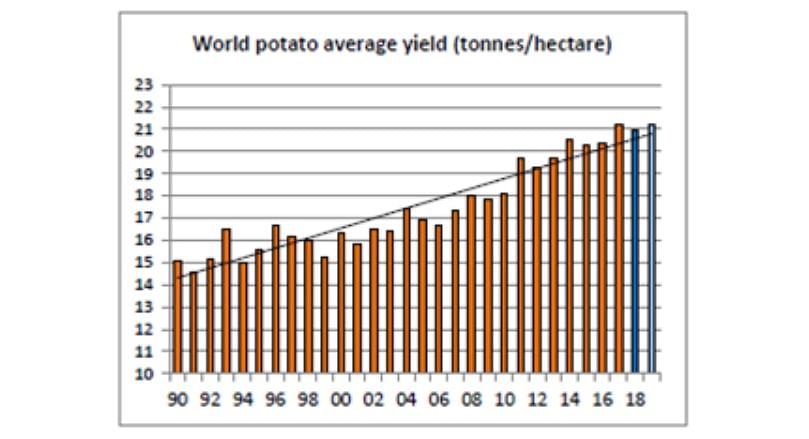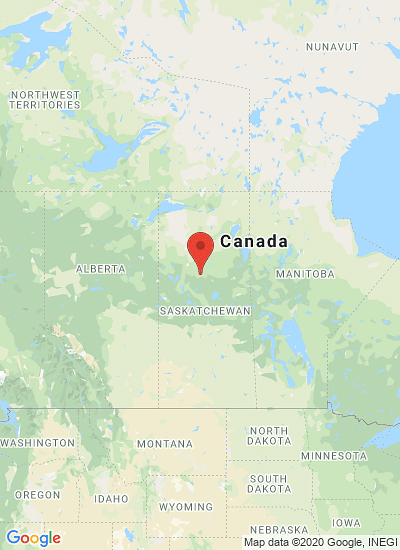World Revised Figures Show Halt in Rise in Potato Production
World Revised Figures Show Halt in Rise in Potato Production

The increase in world potato production stalled in 2018 and failed to recover significantly in 2019. World output slipped by 1.5% to 368.247 million tonnes in 2018 figures just released by the UN Food & Agriculture Organisation show. However, that was still the third highest total ever after 2017 and 2014.
There was a major adjustment in the area figures in 2018, which knocked onto production figures. The UN FAO estimated that the 158 countries it had figures for (or made calculations for) grew by 17.580 million hectares. Last year the organisation estimated a 2017 area figure of 19.099 million hectares, it has now downgraded the 2017 figure to 17.580 million hectare, a 7.9% reduction.
The biggest adjustments were in the Chinese and Russian areas. The new figures estimate that 4.813 million hectares of potatoes were grown in China in 2018, down 1.0% on 2017 and delivering 90.321 million tonnes of crop, which was 2.0% up on figures from the year before.
Previous estimates suggested a 2017 Chinese crop of 99.206 million tonnes from 5.767 million hectares – a 16.5% difference in area. If the new figures are correct, China is further than ever from its long-term aim of doubling potato production to 200 million tonnes.

That is a 3.2% increase in production from a 1.7% smaller area but a drop of nearly 700,000 hectares and seven million tonnes on previous estimates.
The UN FAO did upgrade the French area by about 25 000 hectares and increased estimated Canadian production, although those figures are out of step with official Canadian data.
Using the new figures, average yields slipped 1.2% in 2018. Much of this was due to a big drop in yields in EU countries as a result of the 2018 European drought. The only continent to see an increase in potato plantings in 2018 was Africa – up 3.3% to 1.904 million hectares.
The continent could overtake North America in 2019 or 2020 as the third largest producer of potatoes. More than half the world’s potatoes were grown in Asia in 2018, while Europe accounted for nearly 30% of total production.
Using historical data and knowledge of the 2019 harvest, there is likely to be a small reduction in global plantings – maybe less than 10 000 hectares, while better yields in Europe could result in an increase in production of around five million tonnes, which would be similar to the record output in 2017.
Asian Dominance
Even with the revised figures, China and India accounted for almost 40% of the world’s planted potato area in 2017. Other large Asian producers include Bangladesh, Pakistan and Kazakhstan. During 2018, Nepal overtook Uzbekistan to enter the list of top-25 producers, while Pakistan saw the largest increase in potato production of any of the major producers during 2018.
Ukraine’s potential as a global potato player continues to be unfulfilled. It consistently grows more than 20 million tonnes of potatoes a year and its yields are edging upwards. Despite this, only 7 000 tonnes of ware potatoes were exported from the country in the year ending November 2019, down from 23 000 tonnes the year before.
Ukraine is a major producer of other crops, such as cereals and oilseeds, and has land that is ideal for potato production. The consolidation of EU production continues. Belgium, France, Germany, the Netherlands and the UK accounted for half of the EU 28 plantings in 2018 and 60% of its potato production.
If Poland is added to the five, the six accounted for two thirds of the EU potato area and almost three quarters of production. Further consolidation took place during 2019, when yields improved across Europe, although not dramatically so.
Yield Lag Against Other Crops
Potatoes continue to lag behind other crops when it comes to yield development. The crop is still by far the highest yielding compared to corn (maize), rice, soy and wheat, but they have seen much greater increases over the last 50 years. Average world potato yields increased from 14.3tonnes/hectare in 1968 to 20.9t/ha in 2018 but that was only a 46.2% increase.
That compares to a 158.8% increase for corn, 135.5% for wheat, 109.6% for rice and 94.6% for soy. The next decade should see continued yield development and that could be sped up by greater use of genetic technology and editing.












